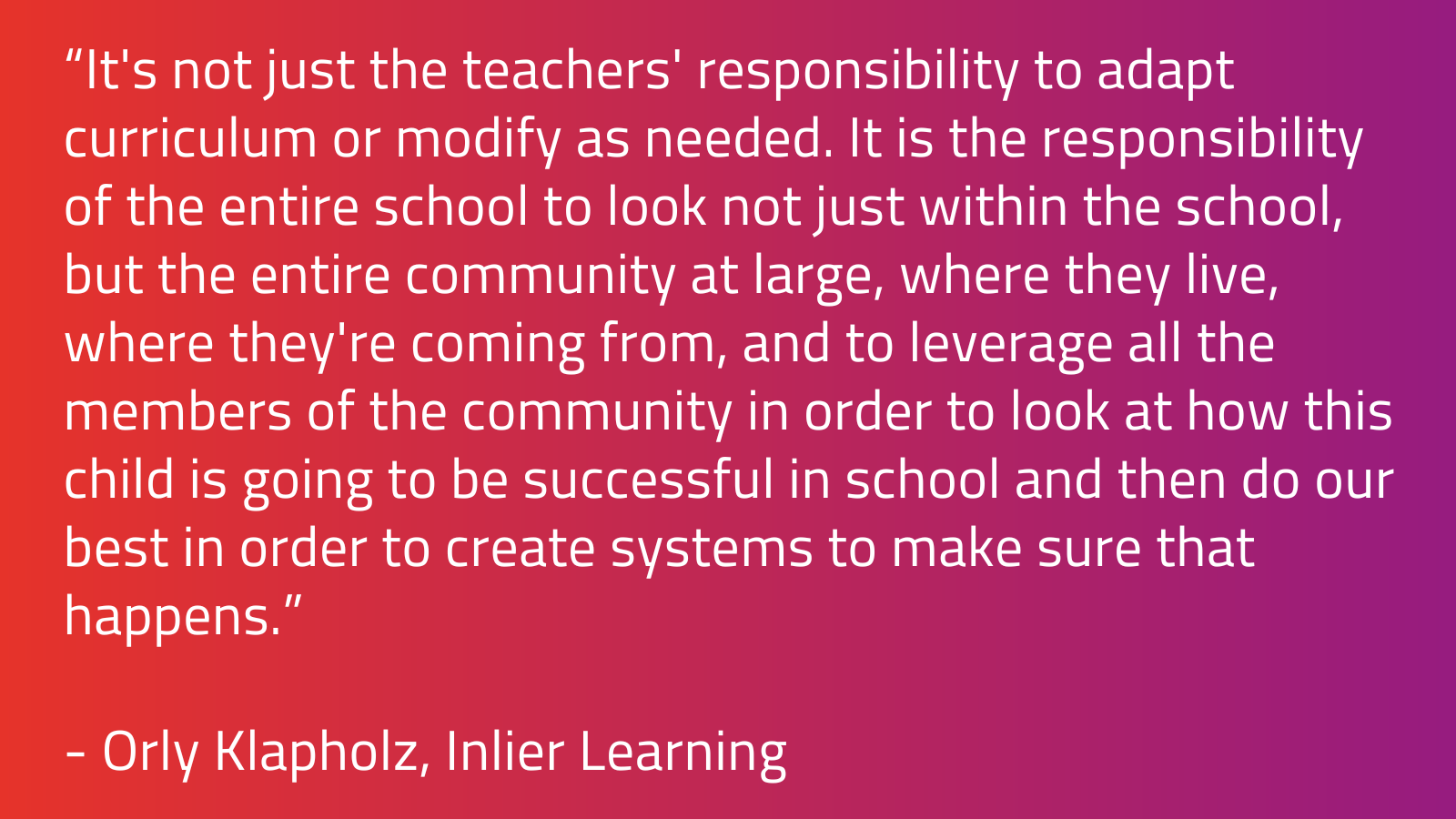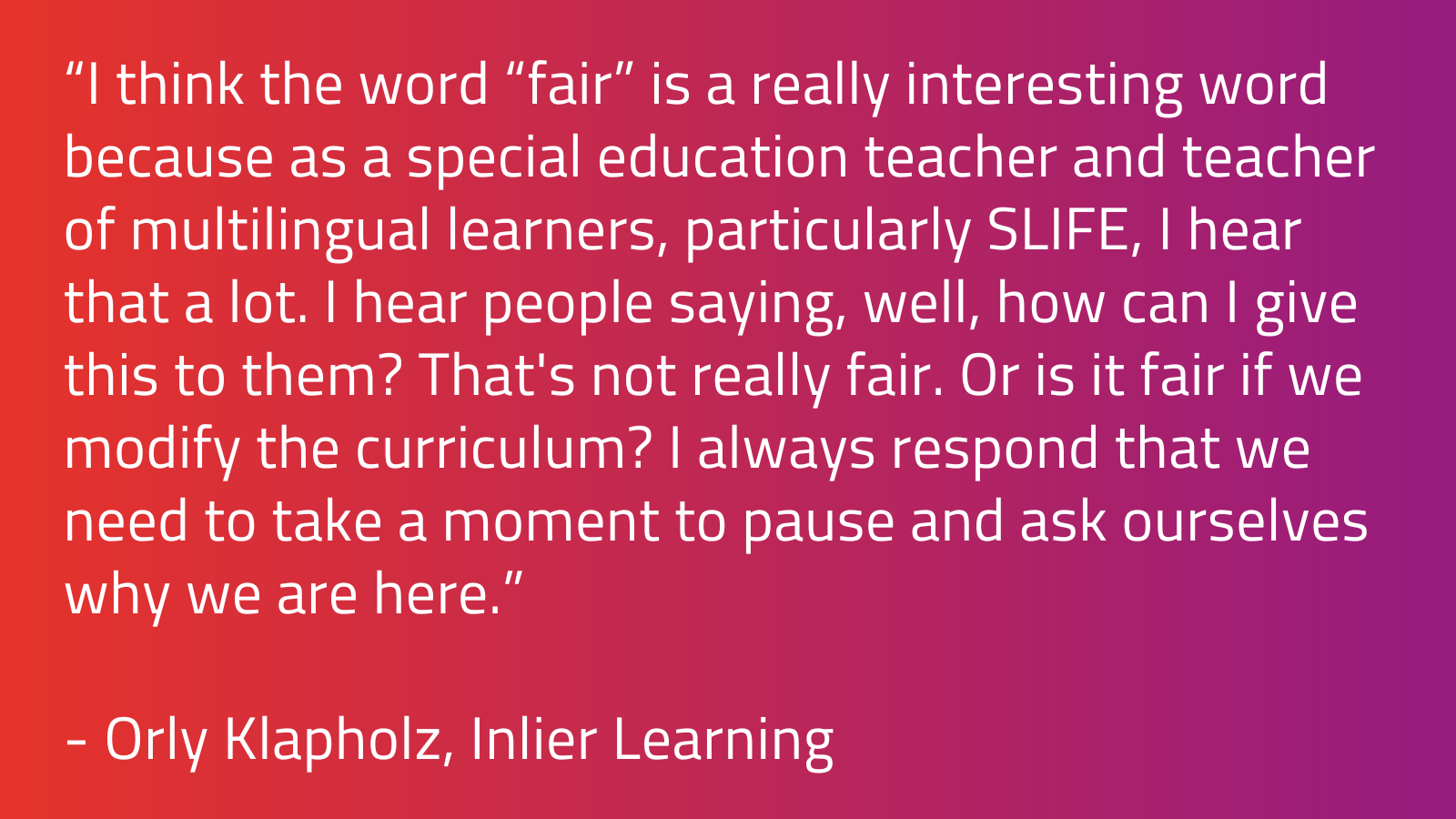An introduction to SLIFE


An introduction to SLIFE
The experiences our students have had outside of the classroom significantly impact how they show up inside the classroom. For English learners and immigrant students in particular, there is a wide spectrum of academic experiences they may have had, and for students with limited or interrupted education (SLIFE) this will pose unique support needs when adjusting to a new school system. It is crucial for educators to understand their stories in order to ensure that the environment we create is supportive for learning.
We spoke with Orly Klapholz, an educator with extensive experience teaching SLIFEs and founder of Inlier Learning to learn more about the current challenges these students face in today's educational environment and how the system can better support them. Listen to the full interview or find key takeaways below to discover how to create a supportive and enriching educational experience for all students.
What is a SLIFE student?
SLIFEs may have some characteristics in common, but there are also many variables in the group of students. For students who have some formal schooling that has been interrupted for two or more years, they may have fled conflict or violence, and may be a refugee in our country as well. Schooling may also have been interrupted due to a natural disaster or high poverty conditions. Some SLIFEs may have never had any formal schooling. Some may have done their schooling in a country where they were taught in English, but many are also English learners. SLIFEs may have experienced extreme stress or trauma during periods of unrest, and all will need some sort of specialized support in order to be successful in the US school system. But a big challenge in SLIFE education is defining and identifying all of the students in this group.
SIFE definition: Challenges with identification
In order to be able to accurately identify SLIFEs and monitor their progress, we have to have a standard federal definition - which does not currently exist. With other subgroups of students such as special education, we can point to legislation for the definition and guiding light to identify and understand how to best support the students. While SLIFEs are mentioned in the newcomer toolkit, which is provided by the United States Department of Education, it doesn't define who they are, nor provide an outline of how to support them or collect data on them.
In the absence of a widely used definition, we currently have a number of states either collecting data on them or defining them in their own way. With states choosing or crafting their own definition of SLIFE, we don't have a way to compare how effective the support we have in place is. We need to be able to look at trends across the country in order to have a clear understanding of how to best support these students.
Risks facing SLIFE students
Beyond the issue of collecting good data on SLIFEs, there is the issue of how that data is being put into practice. In order for the data to be used in a way that drives progress, the cycle should flow from: good data collection to a process where the findings are shared and used to impact policy (high level) before it will then trickle down to support the schools and the students within them. We don’t see this process reaching classrooms and being put into practice often enough. It is crucial for the policies to go beyond compliance and impact what is happening in the classroom.
Research suggests that a staggering 70% of SLIFEs won’t graduate high school with a regular diploma, and that adolescent SLIFEs are most at risk for academic failure. The current system (or lack thereof) is not set up to adequately address the unique needs of this population of students, and the consequences can alter the trajectory of their lives throughout their education journey and beyond. While teachers often recognize the urgency around this issue, it should not fall just to educators to struggle to find the necessary resources to support their SLIFEs.

Strategies for SLIFEs
We know the first step is the identification of SLIFEs. While we may not have many tools available right now, there are some free resources online. One example is a SLIFE intake questionnaire from New York State which can be translated into many different languages. Through using this tool, teachers can work with the families of their students to learn more about their educational background and the experiences they had with the school system prior to coming to your school. Another resource for identifying SLIFEs can be found on the Minnesota state education website. In addition to a free questionnaire/screening, there is a home/native language assessment for students, which can help teachers determine home language literacy and identify any strong candidates for significant intervention.
Orly’s team at Inlier Learning also released a tool called Abee, available through their website starting March 2024. Abee is a screening software that looks at student's prior schooling experiences and interests in order to provide schools and districts holistic data to help both identify newcomers and SLIFE and support all multilingual learners more holistically.
Delivering fair assessments and modifying instruction

If our goal with education is to best service and support our students, then the concern is not whether something is “fair” but rather best for that student. Instead of wondering if it’s fair to give an assessment in two different formats to two different students, consider instead if that is the best thing for each student.
Beyond reimagining the format or approach of big assessments, consider the ways you can deliver low stakes, low stress assessments outside of the more traditional end of unit tests. Asking students to share if they agree or disagree with a question and noticing how a SLIFEs' hesitation goes away with sharing their response over the course of a week or two is really important information for an educator when monitoring their progress.
Another way to make instruction and assessment more inclusive is by designing learning in a format that is supportive of students utilizing their first language. Project based learning is a great technique to use. Project or group work offers a structure for SLIFEs to think about the community they are in and how they as an individual relate and are part of that community. In addition, project-based learning and group work in general, even just working on a worksheet as a group, plays into students' lived experiences, assets, and strengths that they're coming in with. So whether that student has developing literacy, and so they are stronger in their oral development, or even in their preferred language versus in English, project-based and group work can really build on that strength and help students feel more confident in their abilities.
Four key takeaways to improve SLIFE support:
- Advocate whenever possible for improved systems for identification/data collection processes for SLIFEs.
- Focus on understanding their culture (not just the language they speak), learning about their story, and how you can apply that knowledge in your classroom.
- Prioritize alternative means of progress monitoring and assessments by having a sense of where your student is and what artifacts you can gather so you can show this student the progress they are making.
- Plan for how you’re going to support them in foundational numeracy and literacy skills, using group and project-based learning wherever possible.
Orly Klapholtz’s expertise includes Special Education and second language acquisition with specialized training in Orton Gillingham curricula. She has extensive experience teaching multilingual students, particularly those with limited or interrupted formal education, and has presented her research at numerous conferences and trainings. In 2021, she co-founded Inlier Learning with Merary Martinez-Cobian, taking a tech-forward approach to creating integrated solutions for the multilingual population.